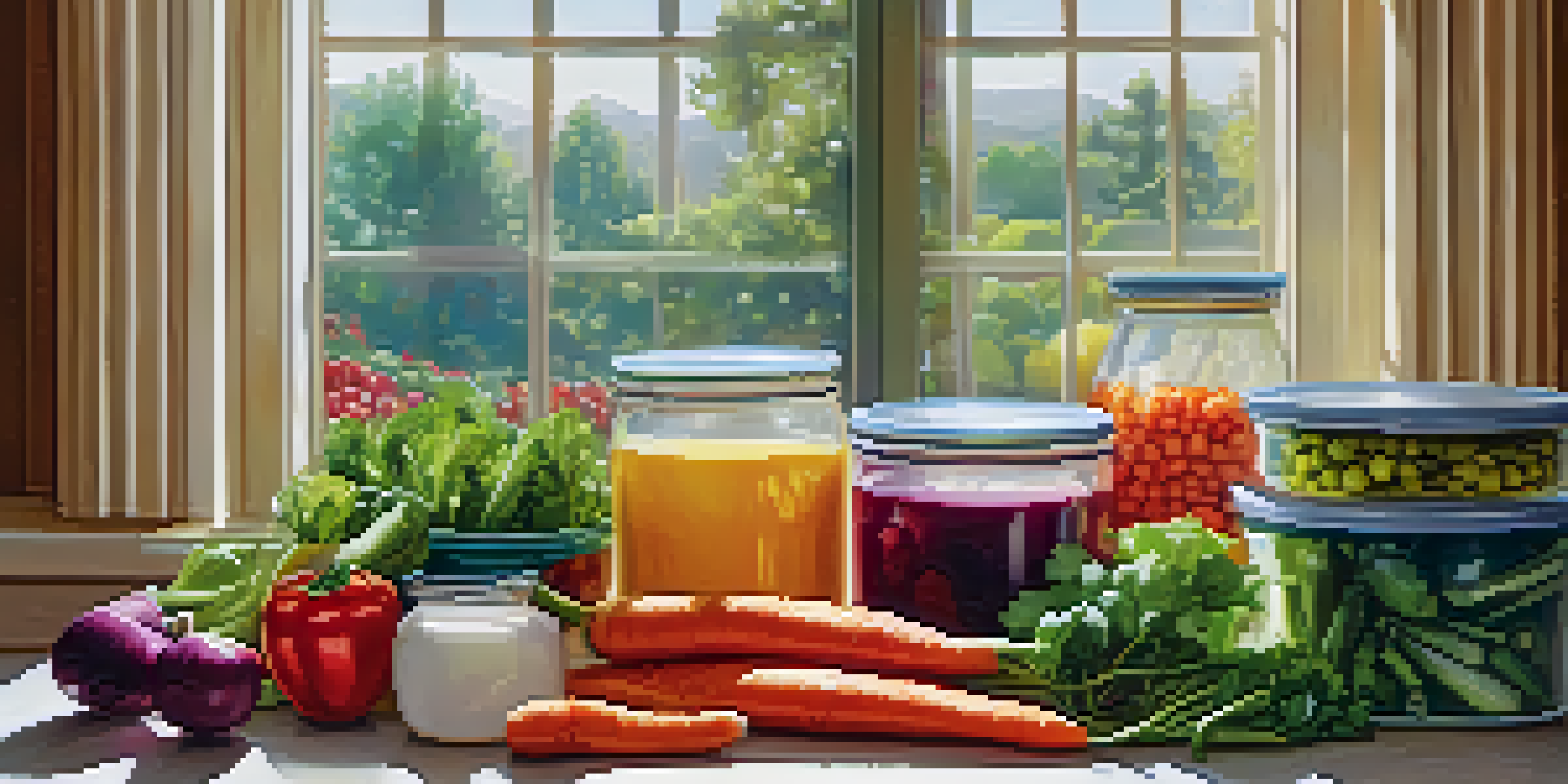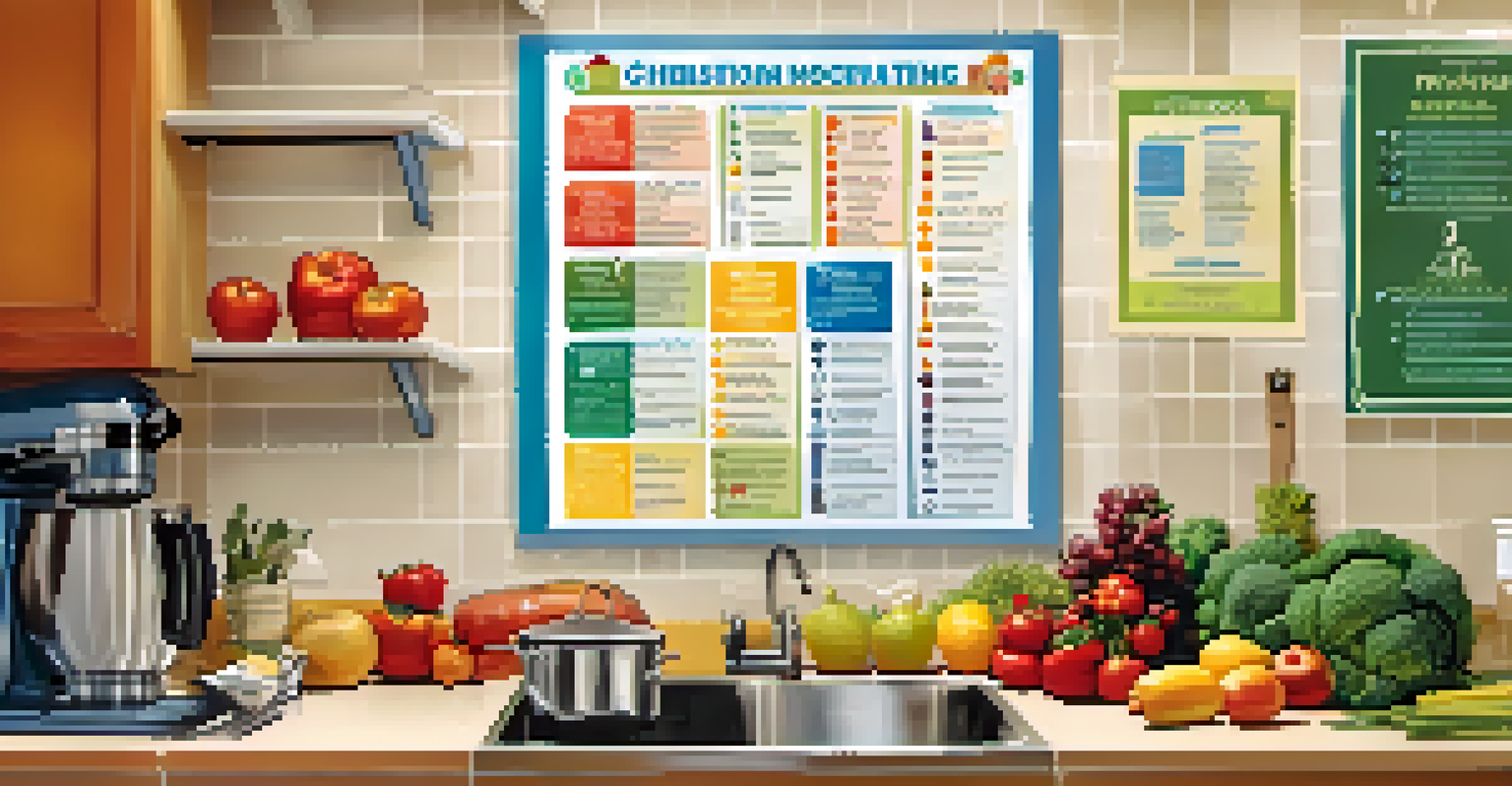Avoiding Cross-Contamination in Vegetarian Cooking

Understanding Cross-Contamination in Cooking
Cross-contamination occurs when harmful bacteria or allergens are transferred from one food item to another. In vegetarian cooking, this can happen when plant-based ingredients come into contact with contaminated surfaces or utensils used for non-vegetarian foods. It's crucial to understand how this can affect the safety and integrity of your meals.
Food safety is not an option; it is a necessity.
For example, if you chop vegetables on a cutting board that was previously used for raw meat, any bacteria left behind can easily transfer to your veggies. This not only poses health risks but can also compromise the vegetarian ethos of your cooking. Knowing where these risks lie is the first step in avoiding them.
By recognizing the potential for cross-contamination, you can implement strategies to keep your vegetarian kitchen safe. This awareness empowers you to create meals that are not only delicious but also healthy and safe for everyone.
Essential Kitchen Tools for Safe Cooking
Using the right tools in your kitchen is fundamental in preventing cross-contamination. Designate separate cutting boards for vegetables and meats if you occasionally cook both. Opt for color-coded utensils—green for veggies, red for meats—so you can easily distinguish between them.

Additionally, invest in high-quality knives that can be easily sanitized. It's surprising how often we overlook the cleanliness of our tools, which can harbor bacteria if not properly maintained. A little care goes a long way in ensuring your cooking environment remains safe.
Preventing Cross-Contamination
Understanding and mitigating cross-contamination ensures the safety and integrity of your vegetarian meals.
Also, consider having separate bowls, strainers, and measuring cups for vegetarian and non-vegetarian ingredients. This small adjustment can significantly reduce the risk of cross-contamination and make your cooking process smoother.
Proper Food Storage Techniques
Food storage plays a vital role in preventing cross-contamination. Always store vegetarian foods separately from meats in your refrigerator, ideally on different shelves. This prevents any drips or spills from contaminating your plant-based items.
The kitchen is a place of transformation, and it’s our job to keep it safe for everyone involved.
Labeling containers can also help you keep track of what’s stored inside and how long it’s been there. Use clear, airtight containers for easy visibility and to maintain freshness. Remember, the cleaner and more organized your fridge is, the less likely cross-contamination will occur.
When it comes to leftovers, ensure they are promptly stored in the fridge and consumed within a safe time frame. By practicing good food storage habits, you can keep your vegetarian meals safe and tasty for longer.
Cleaning and Sanitizing Your Kitchen
Regular cleaning and sanitizing of your kitchen surfaces is crucial in avoiding cross-contamination. Use hot, soapy water to wash surfaces, cutting boards, and utensils after each use, especially after handling raw ingredients. This simple act can drastically reduce bacteria and keep your cooking environment safe.
Consider using sanitizing solutions as well, such as a mixture of water and vinegar or a commercial sanitizer. Make sure to follow the instructions carefully and allow surfaces to dry completely after sanitizing. This ensures that any lingering germs are effectively eliminated.
Essential Kitchen Tools
Using designated tools and color-coded utensils can significantly reduce the risk of cross-contamination in your kitchen.
Additionally, don’t forget about smaller items like sponges and dish towels, which can harbor bacteria if not cleaned regularly. Replace these items frequently to maintain a hygienic kitchen.
Safe Cooking Practices for Vegetarians
Adopting safe cooking practices is essential in preventing cross-contamination. Always wash your hands thoroughly before and after handling any food, especially if switching between different types of ingredients. Handwashing is one of the simplest yet most effective ways to keep your kitchen safe.
When preparing meals, avoid using the same utensils or plates for raw and cooked foods. For instance, if you’ve used a spoon to stir raw vegetable mixtures, don’t use it again without washing it first. This helps to prevent any harmful bacteria from transferring to your finished dish.
Furthermore, ensure that you cook your vegetarian meals to the appropriate temperature, especially if they include ingredients like grains or legumes. This can help to kill any potential bacteria that might have snuck in during preparation.
Educating Others About Cross-Contamination
If you often cook for others, educating them about cross-contamination is vital. Share your knowledge about safe food practices with friends and family, whether you’re hosting a dinner party or cooking for a potluck. This ensures everyone is on the same page and contributes to a safer cooking environment.
Consider creating a simple guide or checklist that highlights the key points about food safety in vegetarian cooking. This can serve as a handy reference when cooking together, making the process smoother and more enjoyable for everyone involved.
Safe Food Storage Practices
Properly storing vegetarian foods separately from meats helps prevent contamination and maintains freshness.
Encouraging open communication about food preparation can also help identify any concerns or questions others may have. This collaborative approach fosters a culture of safety and awareness in the kitchen.
Using Whole Foods to Minimize Risks
Incorporating whole foods into your vegetarian cooking can help minimize the risk of cross-contamination. Whole foods, such as fresh fruits, vegetables, grains, and legumes, often require less processing and handling, which reduces the chances of exposure to harmful bacteria. Plus, they’re packed with nutrients!
When selecting ingredients, try to choose organic or locally sourced options whenever possible. These foods typically undergo fewer handling steps and often come with less packaging, which can harbor contaminants. A focus on whole foods not only benefits your health but also encourages more mindful eating.

Experimenting with whole foods can also inspire creativity in your cooking. You might discover new recipes or flavors that you love while keeping your meals safe and nutritious.
Regularly Reviewing Your Practices
Finally, regularly reviewing your cooking practices can help you identify areas for improvement. Take the time to reflect on your food preparation methods and see where you might be falling short in preventing cross-contamination. This proactive approach ensures you’re always aware of potential risks.
Consider asking for feedback from those you cook for, as they may have insights into your practices that you hadn’t considered. This can be a great way to learn and grow as a cook while enhancing the safety of your meals.
By staying informed and adaptable in your cooking, you can consistently provide safe and delicious vegetarian meals for yourself and your loved ones.